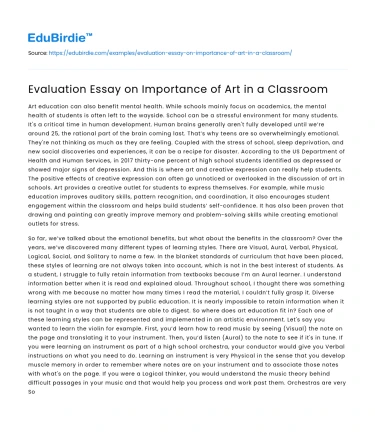Art education can also benefit mental health. While schools mainly focus on academics, the mental health of students is often left to the wayside. School can be a stressful environment for many students. It's a critical time in human development. Human brains generally aren't fully developed until we’re around 25, the rational part of the brain coming last. That’s why teens are so overwhelmingly emotional. They're not thinking as much as they are feeling. Coupled with the stress of school, sleep deprivation, and new social discoveries and experiences, it can be a recipe for disaster. According to the US Department of Health and Human Services, in 2017 thirty-one percent of high school students identified as depressed or showed major signs of depression. And this is where art and creative expression can really help students. The positive effects of creative expression can often go unnoticed or overlooked in the discussion of art in schools. Art provides a creative outlet for students to express themselves. For example, while music education improves auditory skills, pattern recognition, and coordination, it also encourages student engagement within the classroom and helps build students’ self-confidence. It has also been proven that drawing and painting can greatly improve memory and problem-solving skills while creating emotional outlets for stress.
So far, we’ve talked about the emotional benefits, but what about the benefits in the classroom? Over the years, we’ve discovered many different types of learning styles. There are Visual, Aural, Verbal, Physical, Logical, Social, and Solitary to name a few. In the blanket standards of curriculum that have been placed, these styles of learning are not always taken into account, which is not in the best interest of students. As a student, I struggle to fully retain information from textbooks because I’m an Aural learner. I understand information better when it is read and explained aloud. Throughout school, I thought there was something wrong with me because no matter how many times I read the material, I couldn’t fully grasp it. Diverse learning styles are not supported by public education. It is nearly impossible to retain information when it is not taught in a way that students are able to digest. So where does art education fit in? Each one of these learning styles can be represented and implemented in an artistic environment. Let's say you wanted to learn the violin for example. First, you’d learn how to read music by seeing (Visual) the note on the page and translating it to your instrument. Then, you’d listen (Aural) to the note to see if it's in tune. If you were learning an instrument as part of a high school orchestra, your conductor would give you Verbal instructions on what you need to do. Learning an instrument is very Physical in the sense that you develop muscle memory in order to remember where notes are on your instrument and to associate those notes with what's on the page. If you were a Logical thinker, you would understand the music theory behind difficult passages in your music and that would help you process and work past them. Orchestras are very Social as well as they’d force you to work together, listen, and communicate to produce a song. Lastly, you would have to practice Solitarily to fully learn the instrument as much of the learning happens individually. In representing these learning styles, art classes can be used as a reset during a student’s day. Having students participate in a creative interactive activity awakens the part of the brain that helps the student process information the best.
Save your time!
We can take care of your essay
- Proper editing and formatting
- Free revision, title page, and bibliography
- Flexible prices and money-back guarantee
So, what's the issue here? If art education is so beneficial, why is there a debate about whether it should be included in schools? We understood the importance of the arts in schools and communities since 1965 when Lyndon Johnson signed the National Endowment for the Arts. We started out with the grand idea that it's important to support creativity and innovation in schools. So, what happened? When did we decide that nationally accepted and encouraged art programs just didn’t make the cut anymore? Well, let’s rewind back to the economic crash of 2008. Due to the rise of unemployment and lack of income, tax revenue dropped significantly. As public budgets shrunk, it caused budget cuts to roughly eighty percent of school districts. Things looked rough for schools at this point, there had to be a solution. Along came 2010 and the implementation of Common Core Education. Common Core was a set of guidelines to get students ready for college and the workforce. It did so by raising academic standards in math and language and incentivizing schools with a way to get out of the No Child Left Behind requirements. If states participated in common core, they were given the opportunity to win federal grants to fund their schools. Desperate to abide by Common Core, administrators slashed budgets in subjects that were not covered by STEM. School districts cut the funding of non-tested subjects. Music and other arts were the first to go and have been fighting for a spot at the table ever since.






 Stuck on your essay?
Stuck on your essay?

